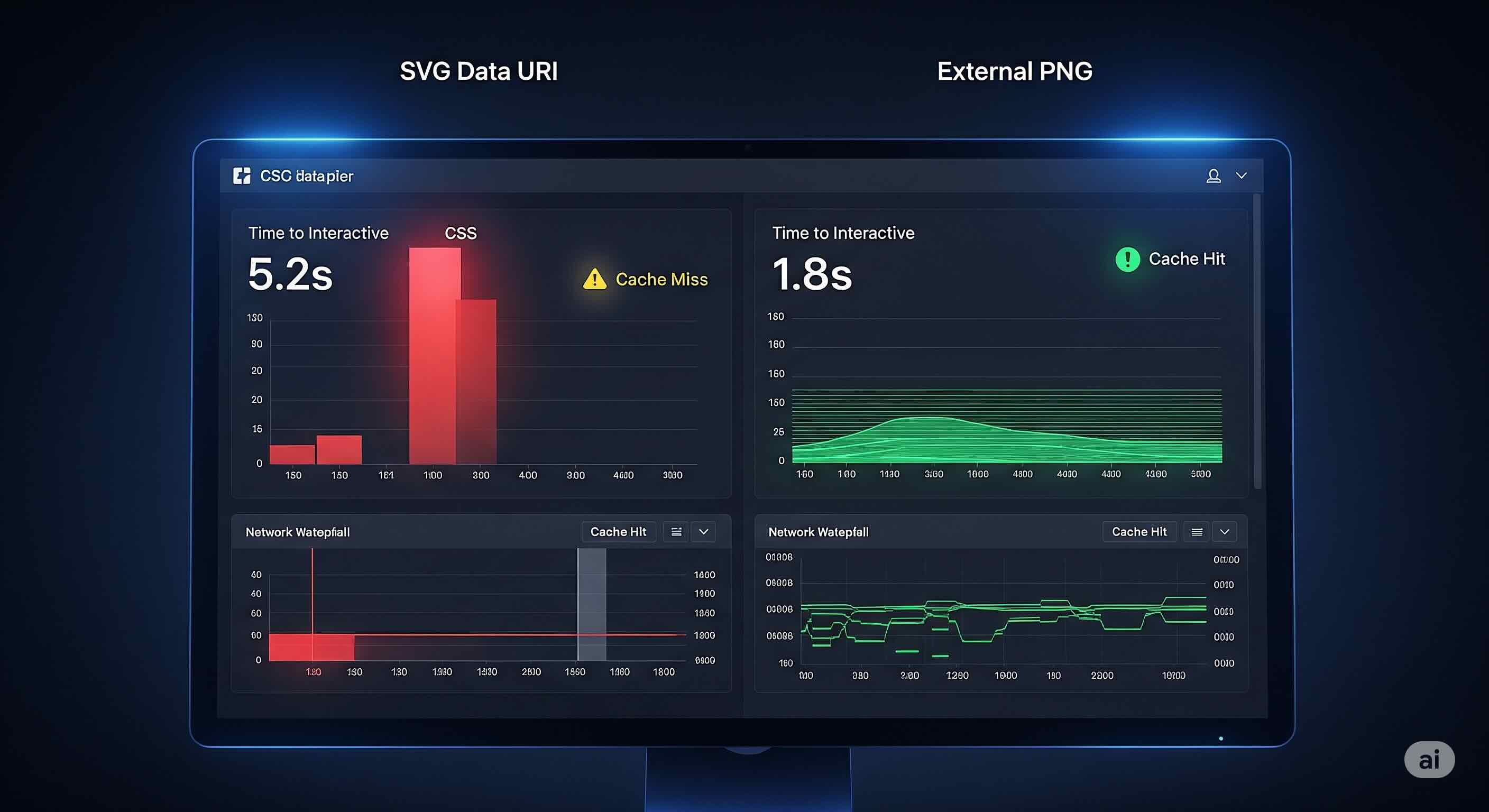Converting SVGs to Data URIs: When to Use PNGs Instead
 iSVGtoPNG Team
iSVGtoPNG Team

In my years of obsessing over web performance, I’ve seen countless techniques rise and fall. But few are as seductive—and as potentially dangerous—as the SVG Data URI. The promise is intoxicating: embed your icons directly into your CSS, eliminate HTTP requests, and watch your page load scores soar. It seems like the ultimate front-end optimization hack.
I’ve been on the front lines of this battle, having built and benchmarked web interfaces on everything from cutting-edge QD-OLED monitors to budget mobile screens. My experience has taught me a crucial lesson: while Data URIs are a powerful tool in a developer's arsenal, they are a scalpel, not a sledgehammer. Using them incorrectly doesn't just fail to improve performance; it can actively harm it, creating bloated stylesheets, caching nightmares, and maintenance headaches.
This guide is born from that experience. We're going to dissect the SVG Data URI, understand its powerful allure, and then, most importantly, define a clear, practical framework for when you should resist the temptation and use a good old-fashioned, reliable PNG instead. This isn't just theory; it's a battle-tested strategy for making smarter, performance-first decisions.
What Exactly is an SVG Data URI?
A Data URI (or Data URL) is a scheme that allows you to embed small files inline in a document. When we talk about an SVG Data URI, we mean taking the entire XML code of an SVG file and placing it directly into our CSS or HTML, typically as a background image.
Instead of linking to a file like url('/icons/my-icon.svg'), you embed the file's content directly:
.my-icon {
background-image: url("data:image/svg+xml,%3Csvg xmlns='http://www.w3.org/2000/svg' viewBox='0 0 100 100'%3E%3Ccircle cx='50' cy='50' r='40' stroke='black' stroke-width='3' fill='red' /%3E%3C/svg%3E");
}
Notice the code is URL-encoded (e.g., < becomes %3C). This is generally more efficient than the alternative, Base64 encoding, which increases data size by about 33%.
The Pros vs. Cons of SVG Data URIs
The allure of "zero requests" is powerful, but it comes with significant, often overlooked, trade-offs. Here's a clear breakdown:
| Pros (The Allure) | Cons (The Hidden Costs) |
|---|---|
| 1. Eliminates HTTP Request Latency: The icon arrives with the CSS, potentially leading to a faster First Contentful Paint (FCP). | 1. The Caching Catastrophe: A single CSS change forces a re-download of the entire stylesheet, including all embedded icons. |
| 2. Perfect Component Encapsulation: A component's styles and assets are all in one place, improving portability. | 2. CSS Bloat & Render Blocking: Increases the size of your render-blocking CSS file, which can slow down initial page rendering. |
| 3. Guaranteed Asset Availability: Avoids the "flash" of missing images while external assets are loading. | 3. Maintenance Nightmares: Encoded strings are hard to read, debug, and update, leading to a brittle workflow. |
The most critical drawback is caching. I once consulted for an e-commerce site that had embedded their 100+ icon set as Data URIs, resulting in a monstrous 700KB CSS file. When we needed to change one icon's color, we invalidated the cache for that massive file for every returning user. The performance hit was immediate. Moving to an external, aggressively cached SVG sprite cut the CSS size by over 80% and dramatically improved load times for repeat visitors.
The Decision Framework: 5 Scenarios Where PNGs Win
So, when should you reach for a PNG? The decision becomes clear when you prioritize caching, complexity, and context. Here are the scenarios where an external PNG is almost always the superior choice.
| Scenario | Why an External PNG is Better |
|---|---|
| 1. Any Asset Used on Multiple Pages | The benefit of having the browser cache it once far outweighs the cost of a single HTTP request on the first visit. This is the golden rule. |
| 2. Complex or Photographic Icons | If an icon contains complex gradients or textures, a well-optimized PNG will offer a much smaller file size than a bloated SVG Data URI. |
| 3. Large Sets of Icons | Embedding a large library of icons is a performance anti-pattern. Use an SVG sprite sheet or individual external files instead to leverage caching. |
| 4. Favicons, App Icons, & Social Media | These use cases have strict requirements for specific file formats (.ico, .png) and dimensions that Data URIs cannot fulfill. |
| 5. When Image SEO Matters | Embedded images are invisible to search engine crawlers. A linked file with a descriptive alt tag is required to be indexed by Google Images. |
For shared assets, you'll want to convert SVG to PNG at various resolutions. You can learn more in our guide to automating @2x/@3x PNG exports. For complex graphics, a careful conversion process is needed to avoid blurry edges or anti-aliasing nightmares.
The Hybrid Strategy: Using the Right Tool for the Right Job
The most professional approach is a hybrid one. It's not about choosing one technique for everything; it's about making a conscious, informed decision for each asset.
- Use Data URIs for: Very small, simple icons that are truly unique to a single component or page element and are not repeated anywhere else on the site. A classic example might be a custom-styled "external link" arrow that only appears in one specific type of info box.
- Use External Files (PNG or SVG) for: Everything else. Logos, navigation icons, social media links, content images, and any asset that is repeated or complex.
And remember, optimization is key regardless of the method. Before embedding an SVG as a Data URI, always run it through an SVG optimizer to make the string as short as possible. If you're using PNGs, they should be run through a high-quality PNG compressor after export to ensure the smallest possible file size.
Conclusion: Think Like a Performance Engineer
The SVG Data URI is a sharp and precise tool, but it's often wielded like a blunt instrument. The allure of "zero requests" can blind developers to the critical importance of caching and the real-world impact of a bloated, render-blocking CSS file. My experience has consistently shown that a thoughtful, caching-first strategy wins every time.
Next time you're about to embed an icon, pause and ask yourself: Is this asset used anywhere else? Is it complex? Is caching it a bigger performance win than saving one HTTP request? By making this conscious choice, you move from simply following a trend to making an informed, professional decision that will result in a faster, more robust, and more maintainable website for your users.

iSVGtoPNG Team
iSVGtoPNG Team is a front-end developer and graphics enthusiast with over 10 years of experience in web technologies. She loves exploring the intersection of design and code.


